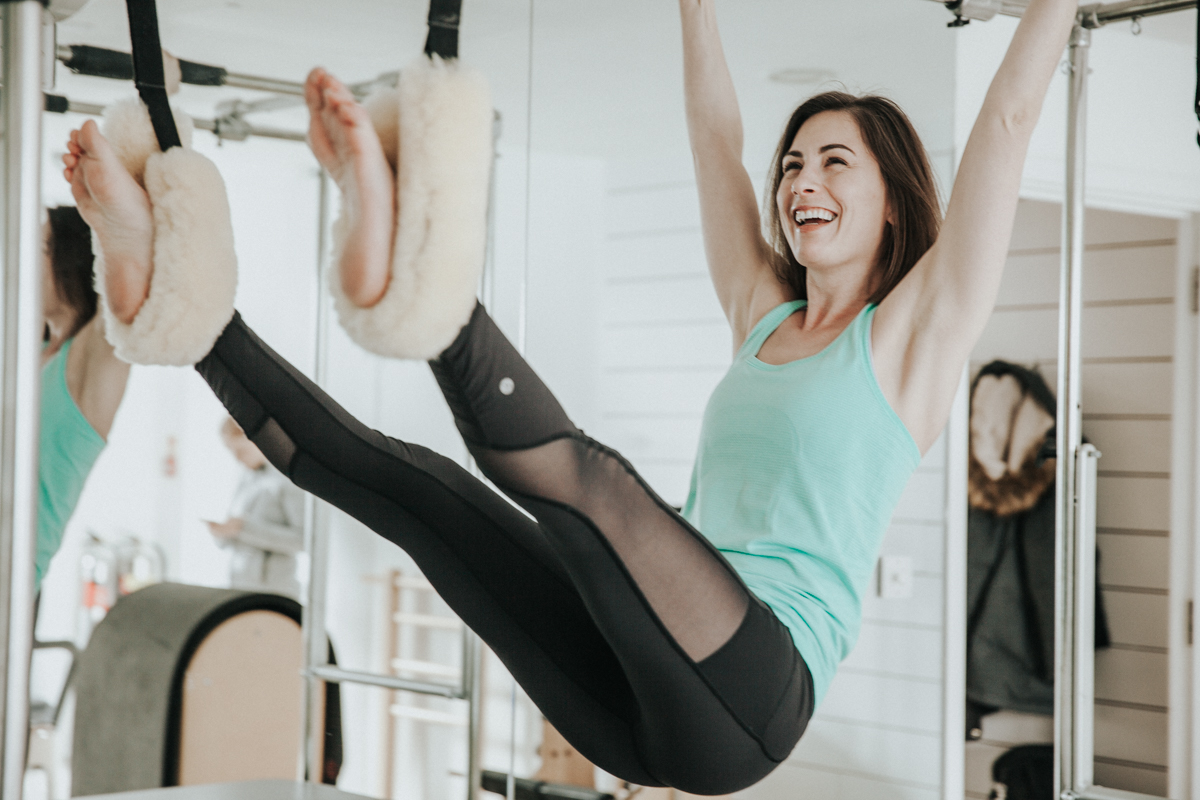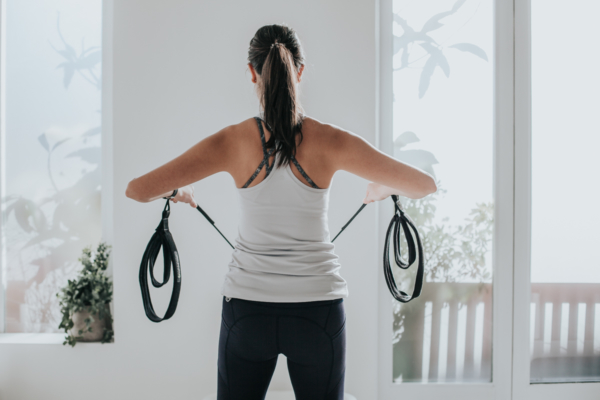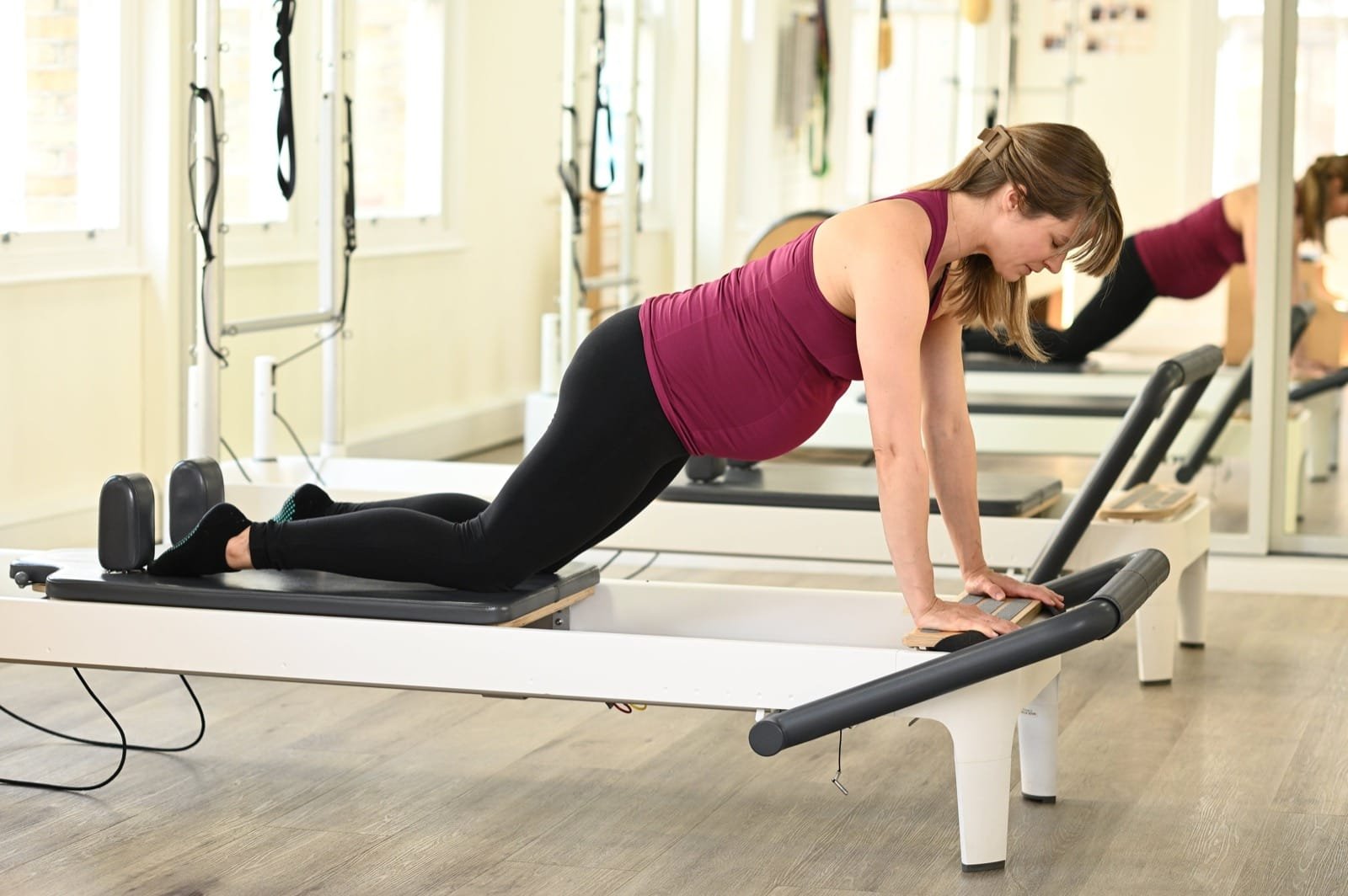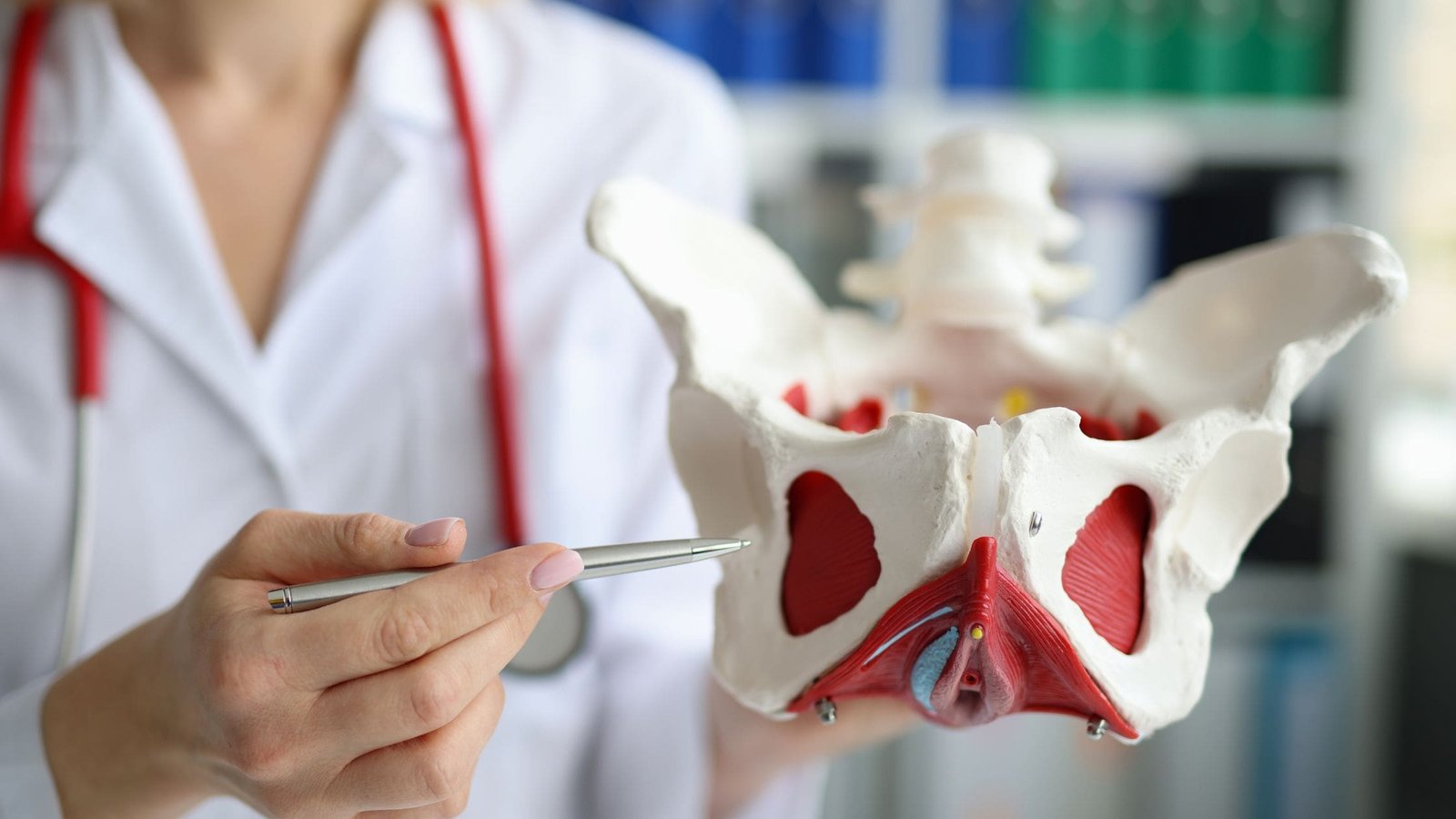Pilates is often associated with ‘core strength’, or considered an easier form of exercise that’s just for women. However the benefits of Pilates are far more extensive and some of them might surprise you! So if you’re wondering, ‘Is Pilates good for you?’, read on and discover 10 surprising benefits of Pilates.
What is Pilates?
If you’re wondering if Pilates is good for you then it’s likely that you’re new to Pilates and you may not even really know what it is! While the popularity of Pilates has increased in recent years, this method of exercise has been around for decades.
Originally developed by Joseph Pilates to improve his own health, Pilates began as a form of exercise that combined the philosophies of mental focus, breathing and physical movement.
The style of movement we are familiar with today really started to take shape in the 1920s, when Joseph and his wife immigrated to New York and set up their first studio. By the 1960s, Pilates was a favoured method of exercise training for New York Ballet dancers, and by the 1980s it became a mainstream form of exercise.
Today, there are a number of different Pilates schools that each teach a variation of the original method while all remaining true to the six original Pilates principles (Breath, Concentration, Control, Precision, Centre and Flow).
Pilates exercises can be performed on the mat or using Pilates Equipment such as the reformer, trapeze table, wunda chair and ladder barrel. While you can certainly expect to engage and challenge your core during a Pilates exercise class, you’ll also find yourself challenging your strength, stability and control, balance, coordination and mobility.
10 Benefits of Pilates
1. Pilates is good for everyone
The great thing about Pilates – and especially equipment Pilates – is that it can be easily modified. This means that Pilates can be safely practised by pretty much everyone.
Using the support of the equipment, Pilates exercises can be broken down so that they become achievable for beginners or people who are returning to exercise following injury or illness. At the same time, the addition (or removal) of a few springs on a machine can make movements more challenging for people who have been practising Pilates for a while or for those who are looking to improve their sports or fitness performance.
Pilates exercises performed both on the mat or with machines can be made suitable for pregnant women, and the support of the equipment also makes it a safe and effective form of exercise for older adults.
All of this means that (with the guidance of a good instructor) Pilates can be practised at all stages of life.
2. Pilates works the whole body
Unlike many forms of exercise, Pilates moves the body in all directions and orientations.
This means that in contrast to lifting weights at the gym, which usually works your body in one direction and one plane, Pilates strengthens and mobilises all muscles of the body.
This makes the body universally stronger and can protect it from injury when you happen to suddenly twist or turn in an unusual way. It can also create more balanced and uniform muscles.
This makes Pilates a great way to complement and enhance a gym-based workout with weights.
3. Pilates improves sports performance
Dancers and elite sports men and women have benefitted from the Pilates method since it was first invented back in the 1920s.
Since then, however, Pilates has become the go-to for fitness fanatics or people playing recreational sports looking to improve their game, for injury prevention and for rehab. And, as many have discovered, you don’t have to be a professional to reap the benefits of Pilates’s game-enhancing properties.
Tennis players (of any standard) can benefit from Pilates. As can people who do triathlons for fun and football after work. Pilates is also an effective way to support your body if you’re a fan of weight-lifting at the gym or running.
After all, Pilates is all about efficiency of movement, creating balanced muscles, and improving mobility in the spine and elsewhere – and these are things all fitness enthusiasts can benefit from.
4. Pilates improves balance
If you’ve ever tried Pilates then you’ll know that certain movements really challenge your balance – and none more so than the side splits performed on a moving reformer platform on a light spring or lunging on the chair with no handles.
Dynamic exercises like these help to improve the efficiency of the body’s deep stabilising muscles. Through regularly practising these kinds of movements, you can also develop better coordination and balance.
Balance, coordination and stability are skills everyone can benefit from having, from sports professionals to desk workers. For athletes like tennis players, for example, developing better balance through Pilates can help them keep upright after having hit a ball when twisting and on one leg.
Developing these skills can be especially beneficial for older people including those with osteoporosis or at a high risk of falls. Studies have consistently shown that Pilates is an effective form of exercise to improve balance in older adults. Furthermore, Pilates has been shown to have a positive effect on balance and function for those with neurological conditions such as Parkinson’s Disease.
5. Pilates is good for spine health
Spinal fluid lubricates the discs and vertebrae of the spinal column. This is what keeps the spine healthy. When these discs dry out (due to old age, illness or injury), an achy and stiff back and restricted movement can be the consequence.
Twisting movements can help combat this dryness. Twisting lubricates the spine and therefore keeps discs plump and healthy.
Pilates is famous for the way it twists and turns the spine in all directions. “Spine twist”, a movement that is performed on the mat, is just one example of the many rotating, twisting and spine-turning exercises you’ll find performed in a Pilates class.
Movement of the spine in all directions also helps mobilise the joints of the spine and keep the muscles that attach to the spine moving freely. Pilates exercises also focus on deep core and spinal strength and control. This helps provide support to the spine during loading activities like running, but also helps us in sustained postures like sitting at a desk all day.
And exercises like these are what make practising Pilates regularly a good way of keeping your spine healthy.
6. Pilates aligns the body
Pilates brings awareness to your alignment and through that can help you feel if and how you are misaligned.
For those who need it, Pilates can then help you find a natural “neutral” alignment (when all three curves of the spine are intact).
Primarily, changes are achieved through performing the right exercises to meet your needs such as improving muscle imbalances or improving the way your joints and spine move.
Equipment-based Pilates can also be beneficial when it comes to finding the right alignment for your body. This is because the equipment provides you with feedback, allowing you to feel for yourself when you’re out of alignment and self-correct. This then helps to reinforce good habits and makes changes to your alignment long-lasting.
Improving your alignment and developing good posture has numerous benefits. These include: appearing slimmer, reducing aches and pains, and better breathing mechanics.
According to Brent Anderson, Pilates instructor, Physiotherapist and CEO of Polestar Pilates, having good posture can also make your muscles function properly. According to him, there is no need to “over-recruit” muscles, like your abs, to activate them. Instead, Anderson explains, “Your [muscles] will work, you just have to be in the right alignment.”
7. Pilates helps with lymphatic drainage
Our lymphatic system is an important part of our immune system. It’s basically our body’s way of disposing of the waste products produced by our cells.
This cellular waste product is carried in the lymph fluid – a fluid that is similar to blood. The lymphatic drainage system contains millions of vessels and flows around the body. Unlike blood, however, which has the heart to pump it around the body, lymph requires breathing, movement of muscles and the flow of intestinal fluids to stimulate its flow.
Getting the lymph fluid flowing freely around the body is essential as this is how toxins reach the lymph nodes and are expelled from the body.
Pilates is great for stimulating lymphatic flow because it gets the body twisting and turning in all planes and orientations. Pilates also focuses on moving and mobilising joints which is particularly useful when it comes to lymphatic movement and detoxification because most of these lymph nodes are found at joints.
Pilates inversion exercises can be a great way of encouraging lymphatic flow from the legs, since many of these exercises raise the legs above the body. When the legs are elevated this encourages flow back to the lymph drainage nodes at the hips.
It seems that Joseph Pilates (the man who invented Pilates) knew what he was saying when he described Pilates as a “cleaning” system for the body.
8. Pilates improves circulation
Deep breathing and good posture improve circulation. And Pilates focuses on both things.
As we’ve already mentioned, Pilates exercises strengthen the postural muscles and improve spine mobility to create good posture. This improves circulation by helping the blood to flow more easily around the body.
On top of that, people who practise Pilates regularly develop good breathing habits through learning to inhale and exhale fully (most of the time we breathe shallowly and in our chests).
This is achieved through bringing attention to the breath and by using it in a conscious way when performing certain exercises.
Other techniques, like diaphragm and abdominal release, which are more common in Pilates sessions, also help people access better movement of their ribs and diaphragm, and this also leads to deeper breathing.
All of this supports good circulation because deep breathing encourages blood to flow to the chest and the heart.
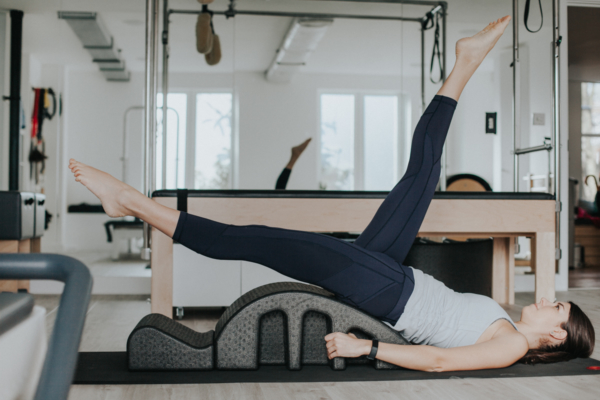
Pilates improves circulation
9. Pilates creates a mind-body connection
Like Yoga and Tai Chi, Pilates was designed by Joseph Pilates to be a mindful form of exercise.
This means that through practising it, Pilates helps to bring your awareness to your body and your movement.
If you’ve tried a Pilates class you’ll know that during exercises you’re encouraged to focus on the sensations inside the body by bringing your attention to what your muscles and joints are doing and how they are feeling, in that moment. Many of the Pilates principles help deepen the mind-body connection through movement, including precision, control and concentration.
There are other benefits of moving mindfully too. Connecting to your body in this way also helps you successfully activate – and relax! – your muscles. By creating a mindful environment while we move, it also helps facilitate better breathing patterns during exercise which can help reduce stress and pain, but also help us build better breathing patterns we can use during higher exertion activities like running.
Plus, as with anything “mindful”, Pilates performed with this intention can also reduce stress and improve cognitive function.
10. Pilates boosts energy level
People often say they feel both relaxed and invigorated by a Pilates session.
And while this may seem contradictory, there is now research to back up these feelings. According to research done at the University of Georgia, people with fatigue problems saw their energy levels improve by 20 percent when they stuck to a routine of low-intensity exercise.
And Pilates is the perfect low-intensity exercise for those of us over-tired, over-worked and in need of an energy boost (pretty much everyone these days).
Pilates works your muscles without overstimulating your nervous system or fatiguing the body. This means you come away from a class or 1:1 session feeling worked out, relaxed and more alert – all at the same time.
Found this article interesting? You might want to check out our post on the myths about Pilates.
What else is Pilates ‘Good for’
While everyone can benefit from Pilates exercise, here at Complete Pilates you’ll experience the extra benefit of having a physiotherapy-led experience. We see a range of individuals of all ages and backgrounds who use the benefits of Pilates to change how they move, feel and perform. Our instructors have a strong understanding of pathology, pain and biomechanics and our 1:1 and small group classes means your exercise program is specifically tailored to your body, needs and goals and is not only effective, but also very safe.
Pilates benefits for pregnancy
There are so many benefits of exercising during your pregnancy, and Pilates is a safe and effective way to keep you moving throughout all your trimesters. A low impact and easily adaptable form of exercise, Pilates can help improve and maintain your core strength and help you cope with the changes in your body and inevitable niggles along the way.
Pilates benefits for post-natal
Carrying and delivering a child puts a big strain on the body and it is well known that a progressive return to exercise is important to help new Mum’s recover, meet the new demands of motherhood and return to their previous levels of activity. Our physiotherapy-led post-natal Pilates classes allow us to assess where your body is post-birth and provide a tailored program that is specific to you.
Pilates benefits for older adults
Exercising as we grow older is incredibly important not just for our physical function but also our mental health and cognition. Pilates is recognised by many in the medical, physiotherapy and exercise professions as being a safe and effective way for older adults to exercise. It has been shown to improve balance, function, cognition and mood in the older population which all help you stay mobile and independent for as long as possible. Read more about Pilates for older adults here.
Pilates for recovery from injury or surgery
If you’ve recently been injured or are recovering from surgery, Rehab Pilates can help your recovery. Because Pilates can be modified to make exercises more or less supportive, it is a great way to begin movement safely and then to progress as your movement and symptoms improve. The equipment enables you to move in multiple positions such as lying down, sitting or standing which means it’s also a great way to move if you’re unable to weight-bear or put load on certain parts of your body.
Pilates for those undergoing cancer treatment
Cancer and the various treatments and medicines used to battle it, take a significant toll on the body. If you’re currently undergoing treatment or in remission, safe and low impact exercise can be a great way to help rebuild your strength and improve your energy and mental health. At Complete Pilates we have practitioners who are specially trained in providing Pilates to those with cancer.
Summary
As you can see, the benefits of Pilates reach far and wide. It is such a diverse and inclusive form of exercise that can be part of everyone’s health and wellness routine. So, come and give it a try and feel the difference in your mind and body today.
Education is key:
These blogs are designed to give information to everyone, however, it is important to remember that everyone is different! If you have not seen one of our therapists and have any questions about injuries, what you have read or whether this may be useful to you, please just ask. We are more than happy to help anyone and point you in the right direction. Our biggest belief is that education is key. The more you understand about your injury, illness and movement, the more you are likely to improve.


